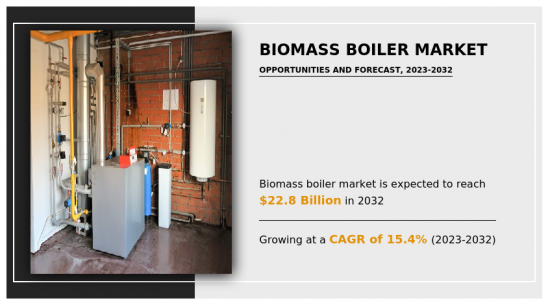
|
시장보고서
상품코드
1365582
바이오매스 보일러 시장 : 원료 유형별, 최종 용도별 - 세계 기회 분석과 산업 예측(2023-2032년)Biomass Boiler Market By Feedstock Type (Woody Biomass, Agriculture and Forest Residues, Biogas and Energy Crops, Urban Residues), By End-Use (Residential, Commercial, Industrial): Global Opportunity Analysis and Industry Forecast, 2023-2032 |
||||||
Allied Market Research의 최신 리포트 '바이오매스 보일러 시장'에 따르면 바이오매스 보일러 시장 2022년 시장 규모는 55억 달러로, 2023-2032년의 CAGR은 15.4%로 성장하며, 2032년에는 228억 달러에 달할 것으로 추정되고 있습니다.

바이오매스 보일러는 식물이나 동물의 배설물에서 얻은 유기물을 연료로 열과 전기를 생산하는 보일러의 일종입니다. 연소실에서 바이오매스 연료를 연소시켜 방출된 열을 물에 전달하여 난방 또는 발전용 증기 또는 온수를 생성하는 방식으로 작동합니다. 바이오매스 보일러는 목재 펠릿, 우드칩, 짚이나 옥수수 줄기와 잎과 같은 농업 잔여물, 스위치그래스나 미스칸사스 같은 에너지 작물, 그리고 에너지 생산 전용으로 재배된 바이오매스 작물 등 다양한 바이오매스 원료를 사용할 수 있습니다.
이러한 보일러는 연료 저장, 연료 공급 시스템, 연소실, 열교환기, 제어 시스템, 배출 제어 기술 등의 부품으로 구성됩니다. 바이오매스 보일러는 재생한 바이오매스 자원을 이용하여 화석 연료를 사용하는 보일러를 대체할 수 있는 지속가능하고 환경 친화적인 보일러를 제공합니다. 이산화탄소 배출량을 줄이고, 에너지 안보를 촉진하며, 현지에서 구할 수 있는 바이오매스 원료를 활용하는 데 기여합니다. 바이오매스 보일러는 다양한 분야에서 광범위하게 사용되고 있습니다. 이 보일러는 식물이나 가축의 배설물에서 얻은 유기물을 연소시켜 열과 전기를 생산하는 데 사용됩니다. 바이오매스 보일러의 주요 용도 중 하나는 가정과 건물의 난방입니다. 바이오매스 보일러는 주거용, 상업용, 산업 시설 등에 사용되어 효율적이고 지속가능한 난방 솔루션을 제공합니다.
목차
제1장 서론
제2장 주요 요약
제3장 시장 개요
- 시장의 정의와 범위
- 주요 조사 결과
- 영향요인
- 주요 투자 기회
- Porter's Five Forces 분석
- 시장 역학
- 촉진요인
- 탈탄소화에 대한 관심의 증가
- 에너지 효율의 상승과 기술의 진보
- 억제요인
- 오염물질 배출과 재 증착
- 기회
- 유리한 정부 인센티브와 정책
- 폐기물 이용과 순환경제
- 촉진요인
- COVID-19 시장에 대한 영향 분석
- 밸류체인 분석
- 주요 규제 분석
- 특허 상황
제4장 BIOMASS 보일러 시장 : 공급원 유형별
- 개요
- 목질 바이오매스
- 농업잔존물 사와 삼림 잔류물
- 바이오가스 및 에너지 작물
- 도시 잔류물
제5장 바이오매스 보일러 시장 : 최종 용도별
- 개요
- 주택용
- 상업용
- 산업용
제6장 바이오매스 보일러 시장 : 지역별
- 개요
- 북미
- 미국
- 캐나다
- 멕시코
- 유럽
- 독일
- 프랑스
- 이탈리아
- 스페인
- 영국
- 기타
- 아시아태평양
- 중국
- 일본
- 인도
- 한국
- 호주
- 기타
- 라틴아메리카·중동 및 아프리카
- 브라질
- 사우디아라비아
- 남아프리카공화국
- 기타
제7장 경쟁 구도
- 서론
- 주요 성공 전략
- 주요 10사의 제품 매핑
- 경쟁 대시보드
- 경쟁 히트맵
- 주요 기업의 포지셔닝, 2022년
제8장 기업 개요
- Viessmann Group
- ETA Heiztechnik GmbH
- HARGASSNER GesmbH
- Guntamatic Heiztechnik GmbH
- Froling Heizkessel-und Behalterbau Ges.m.b.H.
- Woodco
- Thermax Limited
- Forbes Marshall Private Limited
- Hurst Boiler & Welding Co, Inc.
- HDG Bavaria GmbH
According to a new report published by Allied Market Research, titled, "Biomass Boiler Market," The biomass boiler market was valued at $5.5 billion in 2022, and is estimated to reach $22.8 billion by 2032, growing at a CAGR of 15.4% from 2023 to 2032.

A biomass boiler is a type of boiler that uses organic materials derived from plants or animal waste as fuel to generate heat or electricity. It works by burning biomass fuel in a combustion chamber, transferring the released heat to water, and producing steam or hot water for heating purposes or power generation. Biomass boilers can utilize a wide range of biomass feedstocks such as wood pellets, wood chips, agricultural residues such as straw or corn stover, energy crops such as switchgrass or miscanthus, and even dedicated biomass crops grown specifically for energy production.
These boilers consist of components such as fuel storage, a fuel delivery system, a combustion chamber, heat exchangers, control systems, and emission control technologies. Biomass boilers provide a sustainable and environment-friendly alternative to fossil fuel-based boilers by harnessing renewable biomass resources. They contribute toward reducing carbon emissions, promoting energy security, and utilizing locally available biomass materials. Biomass boilers have a wide range of applications across various sectors. These boilers are used to generate heat or electricity by burning organic materials derived from plants or animal waste. One of the primary use of biomass boilers is for heating homes and buildings. They are used in residential, commercial, and industrial settings, providing efficient and sustainable space heating solutions.
The biomass boiler industry is segmented on the basis of feedstock, end user, and region. By feedstock, the market is segmented into woody biomass, agricultural & forest residue, urban residue, and biogas & energy crops. By end user, the market is divided into residential, commercial, and industrial. By region, the market is analyzed across North America, Europe, Asia-Pacific, and LAMEA.
The report covers strategies adopted by key players in the market to sustain the competitive environment and increase their biomass boiler market share. The key players operating in the biomass boiler market include Viessmann Group, ETA Heiztechnik GmbH, HARGASSNER GesmbH, Guntamatic Heiztechnik GmbH, Froling Heizkessel- und Behalterbau Ges.m.b.H., Woodco, Thermax Limited., Forbes Marshall, Hurst Boiler & Welding Co, Inc., and HDG Bavaria GmbH. In addition, the market drivers, restraints, and opportunities are explained in the report.
Key Benefits For Stakeholders
- This report provides a quantitative analysis of the market segments, current trends, estimations, and dynamics of the biomass boiler market analysis from 2022 to 2032 to identify the prevailing biomass boiler market opportunities.
- The market research is offered along with information related to key drivers, restraints, and opportunities.
- Porter's five forces analysis highlights the potency of buyers and suppliers to enable stakeholders make profit-oriented business decisions and strengthen their supplier-buyer network.
- In-depth analysis of the biomass boiler market segmentation assists to determine the prevailing market size.
- Major countries in each region are mapped according to their revenue contribution to the global market.
- Market player positioning facilitates benchmarking and provides a clear understanding of the present position of the market players.
- The report includes the analysis of the regional as well as global biomass boiler market trends, key players, market segments, application areas, and biomass boiler market growth strategies.
Additional benefits you will get with this purchase are:
- Quarterly Update and* (only available with a corporate license, on listed price)
- 5 additional Company Profile of client Choice pre- or Post-purchase, as a free update.
- Free Upcoming Version on the Purchase of Five and Enterprise User License.
- 16 analyst hours of support* (post-purchase, if you find additional data requirements upon review of the report, you may receive support amounting to 16 analyst hours to solve questions, and post-sale queries)
- 15% Free Customization* (in case the scope or segment of the report does not match your requirements, 20% is equivalent to 3 working days of free work, applicable once)
- Free data Pack on the Five and Enterprise User License. (Excel version of the report)
- Free Updated report if the report is 6-12 months old or older.
- 24-hour priority response*
- Free Industry updates and white papers.
Possible Customization with this report (with additional cost and timeline talk to the sales executive to know more)
- End user preferences and pain points
- Technology Trend Analysis
- New Product Development/ Product Matrix of Key Players
- Regulatory Guidelines
- Strategic Recommedations
- Additional company profiles with specific to client's interest
- Additional country or region analysis- market size and forecast
- Expanded list for Company Profiles
- Historic market data
- Key player details (including location, contact details, supplier/vendor network etc. in excel format)
- List of customers/consumers/raw material suppliers- value chain analysis
- Market share analysis of players at global/region/country level
Key Market Segments
By Feedstock Type
- Woody Biomass
- Agriculture and Forest Residues
- Biogas and Energy Crops
- Urban Residues
By End-Use
- Residential
- Commercial
- Industrial
By Region
- North America
- U.S.
- Canada
- Mexico
- Europe
- Germany
- France
- Italy
- Spain
- UK
- Rest of Europe
- Asia-Pacific
- China
- Japan
- India
- South Korea
- Australia
- Rest of Asia-Pacific
- LAMEA
- Brazil
- Saudi Arabia
- South Africa
- Rest of LAMEA
Key Market Players:
- Viessmann Group
- HDG Bavaria GmbH
- HARGASSNER GesmbH
- Woodco
- Thermax Limited
- Guntamatic Heiztechnik GmbH
- Forbes Marshall Private Limited
- ETA Heiztechnik GmbH
- Froling Heizkessel- und Behalterbau Ges.m.b.H.
- Hurst Boiler & Welding Co, Inc.
TABLE OF CONTENTS
CHAPTER 1: INTRODUCTION
- 1.1. Report description
- 1.2. Key market segments
- 1.3. Key benefits to the stakeholders
- 1.4. Research Methodology
- 1.4.1. Primary research
- 1.4.2. Secondary research
- 1.4.3. Analyst tools and models
CHAPTER 2: EXECUTIVE SUMMARY
- 2.1. CXO Perspective
CHAPTER 3: MARKET OVERVIEW
- 3.1. Market definition and scope
- 3.2. Key findings
- 3.2.1. Top impacting factors
- 3.2.2. Top investment pockets
- 3.3. Porter's five forces analysis
- 3.3.1. Low bargaining power of suppliers
- 3.3.2. Low threat of new entrants
- 3.3.3. Low threat of substitutes
- 3.3.4. Low intensity of rivalry
- 3.3.5. Low bargaining power of buyers
- 3.4. Market dynamics
- 3.4.1. Drivers
- 3.4.1.1. Increase in focus toward decarbonization
- 3.4.1.2. Rise in energy efficiency and technological advancements
- 3.4.1. Drivers
- 3.4.2. Restraints
- 3.4.2.1. Emission of pollutants and ash deposition
- 3.4.3. Opportunities
- 3.4.3.1. Favorable Government Incentives and Policies
- 3.4.3.2. Waste utilization and circular economy
- 3.5. COVID-19 Impact Analysis on the market
- 3.6. Value Chain Analysis
- 3.7. Key Regulation Analysis
- 3.8. Patent Landscape
CHAPTER 4: BIOMASS BOILER MARKET, BY FEEDSTOCK TYPE
- 4.1. Overview
- 4.1.1. Market size and forecast
- 4.2. Woody Biomass
- 4.2.1. Key market trends, growth factors and opportunities
- 4.2.2. Market size and forecast, by region
- 4.2.3. Market share analysis by country
- 4.3. Agriculture and Forest Residues
- 4.3.1. Key market trends, growth factors and opportunities
- 4.3.2. Market size and forecast, by region
- 4.3.3. Market share analysis by country
- 4.4. Biogas and Energy Crops
- 4.4.1. Key market trends, growth factors and opportunities
- 4.4.2. Market size and forecast, by region
- 4.4.3. Market share analysis by country
- 4.5. Urban Residues
- 4.5.1. Key market trends, growth factors and opportunities
- 4.5.2. Market size and forecast, by region
- 4.5.3. Market share analysis by country
CHAPTER 5: BIOMASS BOILER MARKET, BY END-USE
- 5.1. Overview
- 5.1.1. Market size and forecast
- 5.2. Residential
- 5.2.1. Key market trends, growth factors and opportunities
- 5.2.2. Market size and forecast, by region
- 5.2.3. Market share analysis by country
- 5.3. Commercial
- 5.3.1. Key market trends, growth factors and opportunities
- 5.3.2. Market size and forecast, by region
- 5.3.3. Market share analysis by country
- 5.4. Industrial
- 5.4.1. Key market trends, growth factors and opportunities
- 5.4.2. Market size and forecast, by region
- 5.4.3. Market share analysis by country
CHAPTER 6: BIOMASS BOILER MARKET, BY REGION
- 6.1. Overview
- 6.1.1. Market size and forecast By Region
- 6.2. North America
- 6.2.1. Key trends and opportunities
- 6.2.2. Market size and forecast, by Feedstock Type
- 6.2.3. Market size and forecast, by End-Use
- 6.2.4. Market size and forecast, by country
- 6.2.4.1. U.S.
- 6.2.4.1.1. Key market trends, growth factors and opportunities
- 6.2.4.1.2. Market size and forecast, by Feedstock Type
- 6.2.4.1.3. Market size and forecast, by End-Use
- 6.2.4.2. Canada
- 6.2.4.2.1. Key market trends, growth factors and opportunities
- 6.2.4.2.2. Market size and forecast, by Feedstock Type
- 6.2.4.2.3. Market size and forecast, by End-Use
- 6.2.4.3. Mexico
- 6.2.4.3.1. Key market trends, growth factors and opportunities
- 6.2.4.3.2. Market size and forecast, by Feedstock Type
- 6.2.4.3.3. Market size and forecast, by End-Use
- 6.3. Europe
- 6.3.1. Key trends and opportunities
- 6.3.2. Market size and forecast, by Feedstock Type
- 6.3.3. Market size and forecast, by End-Use
- 6.3.4. Market size and forecast, by country
- 6.3.4.1. Germany
- 6.3.4.1.1. Key market trends, growth factors and opportunities
- 6.3.4.1.2. Market size and forecast, by Feedstock Type
- 6.3.4.1.3. Market size and forecast, by End-Use
- 6.3.4.2. France
- 6.3.4.2.1. Key market trends, growth factors and opportunities
- 6.3.4.2.2. Market size and forecast, by Feedstock Type
- 6.3.4.2.3. Market size and forecast, by End-Use
- 6.3.4.3. Italy
- 6.3.4.3.1. Key market trends, growth factors and opportunities
- 6.3.4.3.2. Market size and forecast, by Feedstock Type
- 6.3.4.3.3. Market size and forecast, by End-Use
- 6.3.4.4. Spain
- 6.3.4.4.1. Key market trends, growth factors and opportunities
- 6.3.4.4.2. Market size and forecast, by Feedstock Type
- 6.3.4.4.3. Market size and forecast, by End-Use
- 6.3.4.5. UK
- 6.3.4.5.1. Key market trends, growth factors and opportunities
- 6.3.4.5.2. Market size and forecast, by Feedstock Type
- 6.3.4.5.3. Market size and forecast, by End-Use
- 6.3.4.6. Rest of Europe
- 6.3.4.6.1. Key market trends, growth factors and opportunities
- 6.3.4.6.2. Market size and forecast, by Feedstock Type
- 6.3.4.6.3. Market size and forecast, by End-Use
- 6.4. Asia-Pacific
- 6.4.1. Key trends and opportunities
- 6.4.2. Market size and forecast, by Feedstock Type
- 6.4.3. Market size and forecast, by End-Use
- 6.4.4. Market size and forecast, by country
- 6.4.4.1. China
- 6.4.4.1.1. Key market trends, growth factors and opportunities
- 6.4.4.1.2. Market size and forecast, by Feedstock Type
- 6.4.4.1.3. Market size and forecast, by End-Use
- 6.4.4.2. Japan
- 6.4.4.2.1. Key market trends, growth factors and opportunities
- 6.4.4.2.2. Market size and forecast, by Feedstock Type
- 6.4.4.2.3. Market size and forecast, by End-Use
- 6.4.4.3. India
- 6.4.4.3.1. Key market trends, growth factors and opportunities
- 6.4.4.3.2. Market size and forecast, by Feedstock Type
- 6.4.4.3.3. Market size and forecast, by End-Use
- 6.4.4.4. South Korea
- 6.4.4.4.1. Key market trends, growth factors and opportunities
- 6.4.4.4.2. Market size and forecast, by Feedstock Type
- 6.4.4.4.3. Market size and forecast, by End-Use
- 6.4.4.5. Australia
- 6.4.4.5.1. Key market trends, growth factors and opportunities
- 6.4.4.5.2. Market size and forecast, by Feedstock Type
- 6.4.4.5.3. Market size and forecast, by End-Use
- 6.4.4.6. Rest of Asia-Pacific
- 6.4.4.6.1. Key market trends, growth factors and opportunities
- 6.4.4.6.2. Market size and forecast, by Feedstock Type
- 6.4.4.6.3. Market size and forecast, by End-Use
- 6.5. LAMEA
- 6.5.1. Key trends and opportunities
- 6.5.2. Market size and forecast, by Feedstock Type
- 6.5.3. Market size and forecast, by End-Use
- 6.5.4. Market size and forecast, by country
- 6.5.4.1. Brazil
- 6.5.4.1.1. Key market trends, growth factors and opportunities
- 6.5.4.1.2. Market size and forecast, by Feedstock Type
- 6.5.4.1.3. Market size and forecast, by End-Use
- 6.5.4.2. Saudi Arabia
- 6.5.4.2.1. Key market trends, growth factors and opportunities
- 6.5.4.2.2. Market size and forecast, by Feedstock Type
- 6.5.4.2.3. Market size and forecast, by End-Use
- 6.5.4.3. South Africa
- 6.5.4.3.1. Key market trends, growth factors and opportunities
- 6.5.4.3.2. Market size and forecast, by Feedstock Type
- 6.5.4.3.3. Market size and forecast, by End-Use
- 6.5.4.4. Rest of LAMEA
- 6.5.4.4.1. Key market trends, growth factors and opportunities
- 6.5.4.4.2. Market size and forecast, by Feedstock Type
- 6.5.4.4.3. Market size and forecast, by End-Use
CHAPTER 7: COMPETITIVE LANDSCAPE
- 7.1. Introduction
- 7.2. Top winning strategies
- 7.3. Product Mapping of Top 10 Player
- 7.4. Competitive Dashboard
- 7.5. Competitive Heatmap
- 7.6. Top player positioning, 2022
CHAPTER 8: COMPANY PROFILES
- 8.1. Viessmann Group
- 8.1.1. Company overview
- 8.1.2. Key Executives
- 8.1.3. Company snapshot
- 8.1.4. Operating business segments
- 8.1.5. Product portfolio
- 8.1.6. Key strategic moves and developments
- 8.2. ETA Heiztechnik GmbH
- 8.2.1. Company overview
- 8.2.2. Key Executives
- 8.2.3. Company snapshot
- 8.2.4. Operating business segments
- 8.2.5. Product portfolio
- 8.3. HARGASSNER GesmbH
- 8.3.1. Company overview
- 8.3.2. Key Executives
- 8.3.3. Company snapshot
- 8.3.4. Operating business segments
- 8.3.5. Product portfolio
- 8.4. Guntamatic Heiztechnik GmbH
- 8.4.1. Company overview
- 8.4.2. Key Executives
- 8.4.3. Company snapshot
- 8.4.4. Operating business segments
- 8.4.5. Product portfolio
- 8.5. Froling Heizkessel- und Behalterbau Ges.m.b.H.
- 8.5.1. Company overview
- 8.5.2. Key Executives
- 8.5.3. Company snapshot
- 8.5.4. Operating business segments
- 8.5.5. Product portfolio
- 8.6. Woodco
- 8.6.1. Company overview
- 8.6.2. Key Executives
- 8.6.3. Company snapshot
- 8.6.4. Operating business segments
- 8.6.5. Product portfolio
- 8.7. Thermax Limited
- 8.7.1. Company overview
- 8.7.2. Key Executives
- 8.7.3. Company snapshot
- 8.7.4. Operating business segments
- 8.7.5. Product portfolio
- 8.7.6. Business performance
- 8.8. Forbes Marshall Private Limited
- 8.8.1. Company overview
- 8.8.2. Key Executives
- 8.8.3. Company snapshot
- 8.8.4. Operating business segments
- 8.8.5. Product portfolio
- 8.9. Hurst Boiler & Welding Co, Inc.
- 8.9.1. Company overview
- 8.9.2. Key Executives
- 8.9.3. Company snapshot
- 8.9.4. Operating business segments
- 8.9.5. Product portfolio
- 8.10. HDG Bavaria GmbH
- 8.10.1. Company overview
- 8.10.2. Key Executives
- 8.10.3. Company snapshot
- 8.10.4. Operating business segments
- 8.10.5. Product portfolio

















